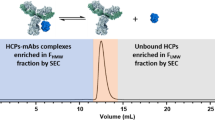Abstract
Recombinant monoclonal antibodies (mAbs) as drug products are normally expressed in non-human cell lines and then purified by affinity chromatography. Low amount of residual host cell proteins (HCPs) still remain in the final products, causing potential safety risks. Capillary electrophoresis (CE) has been employed as a powerful separation tool coupling with mass spectrometry (MS) for the analysis of protein therapeutics. This chapter introduces studies that take advantages of CE-MS for the identification and quantification of trace amount of HCPs in antibody drug products.
Access this chapter
Tax calculation will be finalised at checkout
Purchases are for personal use only
Similar content being viewed by others
References
Abbas AK, Lichtman AH, Pillai S (2014) Cellular and molecular immunology, 8th edn. Saunders Co.
Falkenberg FW et al (1995) In vitro production of monoclonal antibodies in high concentration in a new and easy to handle modular minifermenter. J Immunol Methods 179:13–29
Kohler G, Milstein C (1975) Continuous cultures of fused cells secreting antibody of predefined specificity. Nature 256:495–497
Nissim A, Chernajovsky Y (2008) Historical development of monoclonal antibody therapeutics. Handb Exp Pharmacol 181:3–18
Brekke OH, Sandlie I (2003) Therapeutic antibodies for human diseases at the dawn of the twenty-first century. Nat Rev Drug Discov 2:52–62
Wurm FM (2004) Production of recombinant protein therapeutics in cultivated mammalian cells. Nat Biotech 22:1393–1398
Spadiut O, Capone S, Krainer F, Glieder A, Herwig C (2016) Microbials for the production of monoclonal antibodies and antibody fragments. Trends Biotechnol 32:54–60
Robert F et al (2009) Degradation of an Fc-fusion recombinant protein by host cell proteases: identification of a CHO cathepsin D protease. Biotechnol Bioeng 104:1132–1141
Xue L, Johnson R, Gorovits B (2010) Prevalence and isotypic complexity of the anti-Chinese Hamster ovary host cell protein antibodies in normal human serum. AAPS J. 12:98–106
Zhu-Shimoni J et al (2014) Host cell protein testing by ELISAs and the use of orthogonal methods. Biotechnol Bioeng 111:2367–2379
Rey G, Wendeler MW (2012) Full automation and validation of a flexible ELISA platform for host cell protein and protein A impurity detection in biopharmaceuticals. J Pharm Biomed Anal 70:580–586
Krawitz DC, Forrest W, Moreno GT, Kittleson J, Champion KM (2006) Proteomic studies support the use of multi-product immunoassays to monitor host cell protein impurities. Proteomics 6:94–110
Jin M, Szapiel N, Zhang J, Hickey J, Ghose S (2010) Profiling of host cell proteins by two-dimensional difference gel electrophoresis (2D-DIGE): implications for downstream process development. Biotechnol Bioeng 105:306–316
Zhang Z, Pan H, Chen X (2009) Mass spectrometry for structural characterization of therapeutic antibodies. Mass Spectrom Rev 28:147–176
Bracewell DG, Francis R, Smales CM (2015) The future of host cell protein (HCP) identification during process development and manufacturing linked to a risk-based management for their control. Biotechnol Bioeng 112:1727–1737
Doneanu C et al (2012) Analysis of host-cell proteins in biotherapeutic proteins by comprehensive online two-dimensional liquid chromatography/mass spectrometry. MAbs 4:24–44
Schenauer MR, Flynn GC, Goetze AM (2012) Identification and quantification of host cell protein impurities in biotherapeutics using mass spectrometry. Anal Biochem 428:150–157
Zhang Q et al (2014) Comprehensive tracking of host cell proteins during monoclonal antibody purifications using mass spectrometry. MAbs 6:659–670
Thompson JH et al (2014) Improved detection of host cell proteins (HCPs) in a mammalian cell-derived antibody drug using liquid chromatography/mass spectrometry in conjunction with an HCP-enrichment strategy. Rapid Commun Mass Spectrom 28:855–860
Doneanu CE et al (2015) Enhanced detection of low-abundance host cell protein impurities in high-purity monoclonal antibodies down to 1 ppm using ion mobility mass spectrometry coupled with multidimensional liquid chromatography. Anal Chem 87:10283–10291
Zhu G et al (2016) Capillary zone electrophoresis tandem mass spectrometry detects low concentration host cell impurities in monoclonal antibodies. Electrophoresis 37:616–622
Zhu G et al (2014) Absolute quantitation of host cell proteins in recombinant human monoclonal antibodies with an automated CZE-ESI-MS/MS system. Electrophoresis 35:1448–1452
Zhu G et al (2012) A rapid cIEF–ESI–MS/MS method for host cell protein analysis of a recombinant human monoclonal antibody. Talanta 98:253–256
Kuroda Y et al (2005) On-line capillary isoelectric focusing–mass spectrometry for quantitative analysis of peptides and proteins. J Pharm Biomed Anal 37:423–428
Wang Y, Fonslow BR, Wong CCL, Nakorchevsky A, Yates III JR, Improving the comprehensiveness and sensitivity of sheathless capillary electrophoresis–tandem mass spectrometry for proteomic analysis. Anal. Chem. 84(20):8505–8513
Betgovargez E, Bryan F, Johansen E (2015) Ultra-sensitive host cell protein detection using CESI-MS with SWATH® acquisition. Sciex
Author information
Authors and Affiliations
Corresponding author
Editor information
Editors and Affiliations
Rights and permissions
Copyright information
© 2016 Springer International Publishing Switzerland
About this chapter
Cite this chapter
Zhang, L. (2016). Host Cell Protein Analysis Using CE-MS. In: Xia, J., Zhang, L. (eds) Capillary Electrophoresis-Mass Spectrometry. Springer, Cham. https://doi.org/10.1007/978-3-319-46240-0_5
Download citation
DOI: https://doi.org/10.1007/978-3-319-46240-0_5
Published:
Publisher Name: Springer, Cham
Print ISBN: 978-3-319-46238-7
Online ISBN: 978-3-319-46240-0
eBook Packages: Biomedical and Life SciencesBiomedical and Life Sciences (R0)




